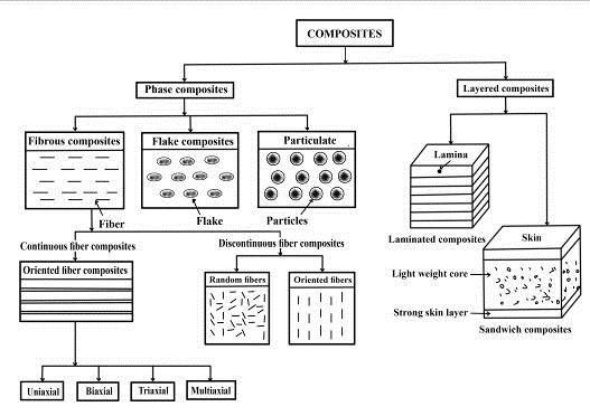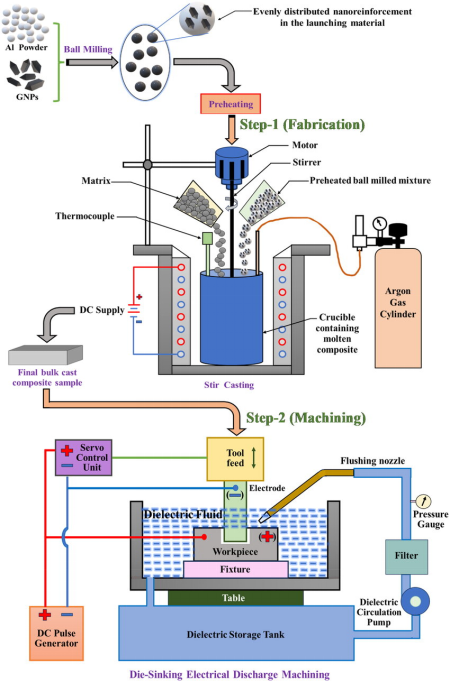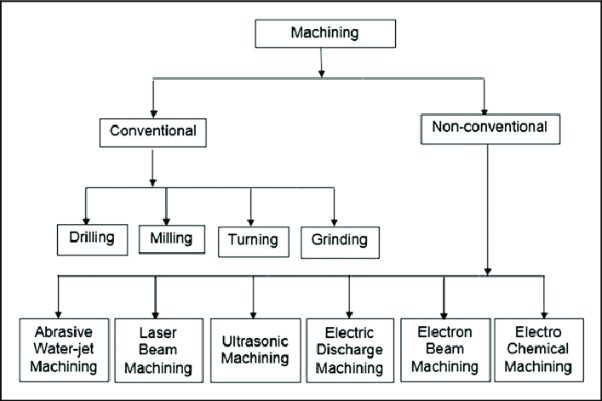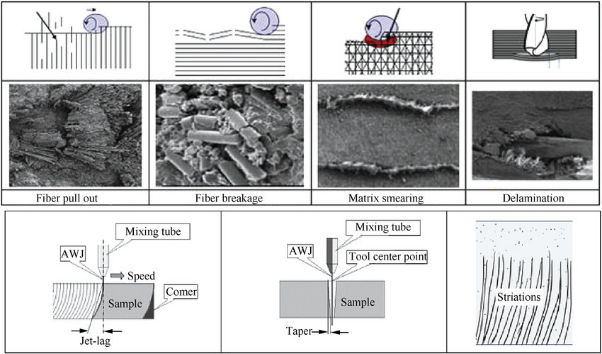Composite Machining Expert Tips: Benefits, Applications
 Oct 08,2024
Oct 08,2024

Composites are engineered materials. These are a combination of two or more elements with different properties. for example, carbon-fiber composites are composed of carbon fiber and epoxy resin to produce carbon fiber reinforced plastic. The composite machining is shaping the material with machining methods. These methods require specialized equipment and tools because composite parts have layered structure and high hardness.
Classification of composite.

What is Composite Machining?
Composite machining is the creating or shaping the composites with machining methods like milling, drilling, trimming or turning. Composite parts like glass fiber reinforced plastic have a features quality that the different constituents used in its production remain separate and on a macroscopic level within the finished structure.
Fabrication and machining of composite

Are Composites Machinable?
Composites are difficult to machine. This is because they have a unique combination of properties due to different types of material combination. It requires special technique and tools to machine the composite.
Definition of Composite Machining
Composite machining defines as the two or more different constituent materials are combined such as carbon fiber reinforced plastic and shaped with a machining process like milling, drilling, or trimming. The constituent material remains sperate within the finished structure.
Industries and Applications
High-tech and advanced industries mostly utilised Composite materials. Because these are intricate material with unique properties with good surface finish. These industries are NASA, defence organization and automotive, architectural, marine, transport and aerospace.
In aerospace, fiberglass reinforced plastic has been widely used but now sandwich carbon composites parts are being employed immensely because of goof surface finish. Aluminium composites are also used widely.
In automotive industry, composite parts provide weight and fuel efficiency more than steel.
The defence organization used carbon fibre reinforced plastic in guns, marine warships and in navigation systems.
Benefits of Composite Machining for Custom Parts
There are many advantages of composite machining for custom parts. Some of them as:
Maintain Material integrity
Machining Composite parts have high strength and are lightweight and have good surface finish. They allow high precision in parts without compromising its strength.
Design Flexibility
Machining methods have design flexibility and can create intricate and complex shapes. That is why machining composites are valuable automotive and aerospace industries because aerodynamics and weight are major concerns.
Cost Efficiency
Initial cost of machining composite can be high, but it saves overall cost of the project. Machining helps the composite parts like tubes or rods to fit exactly and create bonding surface these lightweight materials have less transportation charges and energy consumption.
What are the 4 Types of Composites?
The major four types of composites that can be machined are explained below:
Machining Carbon Fiber Composites
Machining carbon fiber is difficult with traditional tools. Milling on CNC machining can give the best result for carbon fiber reinforced plastic machining. Using a High-Z router with milling tools can easily cut the carbon reinforced plastic and cutouts and holes can be done easily with circular milling.
Machining Polymer Composites
Various processes are involved in machining of polymer composites like turning, milling or grinding to get good surface finish. Micromachining techniques are now being used on polymer composites to address the challenges occur in machining like tool wear or for delamination prevention.
Machining Fiberglass and Timber Composites
Fiberglass is a high-strengthened and lightweight material. It inherits its strength from fine glass fiber wove. Machining fiber glass with different patterns and glass type provides different levels of strength in composite part. For timber composites. Milling after sawing, is the most used methods. Milling machines have milling heads and tools with fixed tungsten carbide blade.
Aerospace Composites Machining
Aerospace machining involves manufacturing of parts and to be assembled into aerospace machine parts. This is the most complex technology among all the machining parts. Machining is carried out by milling, turning, drilling or grinding.
CNC Machining Techniques of Composite Materials
The CNC machining methods used for composite parts are as:
Machining Drilling and Fastening Composites Guide
diamond coated carbide drills are used for drilling the composites like carbon fiber reinforced plastic or glass fiber, Kevlar, graphite and abrasive plastics. During and fastening, delamination is the major risk when forming holes. It occurs when a bond or matrix crack in composite. This makes the material brittle and prone to failure.
CNC Cutting, CNC Milling, CNC Turning and CNC Routing
Composites have high hardness and wear resistance. For CNC cutting, turning and milling the composite parts, diamond coated tools are used. These are cost effective and good give results of machining while retaining the original composite properties.
In comparison with tungsten carbide tool, the polycrystalline diamond tools for milling, cutting, turning and routing, provide better cutting speed, delamination prevention, better surface finish and tool wear resistance.
Trimming, Finishing, and Roll Wrapping
Trimming and finishing are the post-processing methods in machining. It is carried out to obtain final geometry part with better surface finish. Various trimming tools are used but laser trimming is used for composite material. Roll wrapping provides extensive customization for composite material.

CNC Machining Centers
CNC Machining Center is the Computerized Numerically Controlled Milling Machine. This center has 3 axis minimum, as X, Y, and Z. This is integrated with milling or drilling type tool mounted in a rotating spindle.
What are the Challenges in Machining of Composites?
Delamination, Fraying, and Dust
Composites are created with multiple layers which are prone to separation during machining. This separation is delamination which is the greatest concern composite machining. Delamination can affect structural integrity and quality of components drastically. The delamination prevention can be done by using diamond coated tools instead of tungsten carbide tools.
Fraying of composite can occur during machining process like abrasive water jet cutting (AWJC). This can lead to splintering and delamination of composite layers.
Dust is formed when composite is shaped like resin is molding into shape by cutting or sanding. This can cause server health issues like skin redness, eye irritation, or swelling.
Challenges during machining composite material

Cutting Tools for Composites Machining
Best Cutting Tools
The best cutting tools used for composite machining are polycrystalline diamond tools and CVD coated diamond tools. These are best for carbon fiber, glass fiber, Kevlar, abrasive plastic and many more. These can be modified with features like reduced neck, drill point end, burr end cut and drawing cut etc.
Specialized Machining Tools for Carbon Composites
CVD coated diamond tools are used for carbon composites. Carbon composites have high abrasion properties. They can damage the carbide and diamond coating-based tools. Therefore, CVD Coated tools are best for carbon fiber reinforced plastics.
Machining Fiberglass: Tool Selection and Wear
The cutting tools used for fiberglass are hand-held hacksaw with a fine-tooth blade, chop-saw and a portable bandsaw These are integrated with a diamond cutting blade and an abrasive blade cutter. These avoid the tool wear during the machining of fiberglass and best for delamination prevention.
Best Practices for CNC Machining of Composites
There are few tips that must be used while machining composite to avoid major and common occurring issues.
The Role of Cooling in Composite Machining
Cooling has direct effect in the machining efficiency and final product quality. If the cooling is effective, it does not build up the generated heat during machining. This further prevents the damage to tools and composite material.
Coolant or Dry Machining for Composite Materials?
Cooling lubricants are used to dissipate generated heat during machining. It reduces the friction between tools and workpiece and helps in removing chips.
For reliable dry machining, the drill must be used with a countersink step. This specialized geometry tools helps in avoiding the heat transferring from tool to workpiece.
Avoiding Material Damage During Machining
Cutting tools must be used that are sharp and can maintain a required force to prevent the chips formation. Utilizing correct feed rate, cutting speed and coolant can avoid the tool rubbing, heat generation and material damage.
Machining Carbon Fiber VS Polymer Composites
Carbon fibers are difficult to machine. It is abrasive material and has anisotropic and non-homogeneous structure. It can easily be delaminated, or tool wear can occur. Polymer composites are also difficult to machine. But the level of difficulty in each composite material depends on the desired application and its requirements.
 Tel/WeChat:
Tel/WeChat:  Email:
Email: 
 Home
Home
 304 vs 18-8 Stainless Steel Which is Better
304 vs 18-8 Stainless Steel Which is Better 







